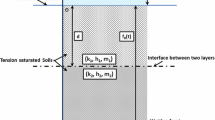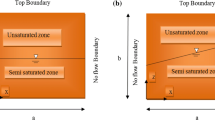Abstract
Formation of soil horizon boundaries are commonly qualitatively described, their formation and time evolution are rarely quantified by adequate mathematical modeling. In this paper, analytical (using conformal mappings) and numerical (involving HYDRUS2D simulations) methods are employed to model 2D infiltration-induced Darcian flows within a layered fine/coarse soil substrate system featuring a wedge-shaped interface, considering both saturated and unsaturated conditions. Initial-boundary value problems to the Richards (in particular, Laplace’s) partial differential equations are set in domains with geometry of interfaces more complex than in regular soil profiles. The patterns of 2D distribution of physical characteristics (streamlines, isobars, velocities, etc.) are found in two variants of such a system (loam/gravelly non-capillary material, loam/sand), with comparison of analytical and numerical models. The novelty of the results is in the analysis of concentrating streamlines with maximum water flow rates and fastest travel time of advected marked particles at the tops of the jagged interface of the soil textures and the unsaturation of the underlying coarse-dispersed substrates during pressure infiltration of water in such systems. Also, if the soil surface is subject to small infiltration fluxes, the opposite phenomenon of capillary barrier, i.e. diversion of the infiltration flux from the top of the interface of the coarse substratum, is demonstrated in HYDRUS2D simulations. Prediction of morphological variations of soil profiles with non-horizontal interfaces, which undergo time-factor controlled anthropogenic drivers, is important for theoretical soil hydrophysics and hydrological and soil/geotechnical engineering.





Similar content being viewed by others
Notes
We return to dimensionless quantities for comparisons with numerical (HYDRUS) results below, in Subsection 3.2.
REFERENCES
M. Abramowitz and I. A. Stegun, Handbook of Mathematical Functions with Formulas, Graphs, and Mathematical Tables (National Bureau of Standards, Washington, 1964).
A. Al-Maktoumi, A. Kacimov, S. Al-Ismaily, and H. Al-Busaidi, “Infiltration into two-layered soil: the Green-Ampt and Averyanov models revisited,” Transp. Porous Media 109, 169–193 (2015).
S. Al-Saqri, A. Al-Maktoumi, S. Al-Ismaily, A. Kacimov, and H. Al-Busaidi, “Hydropedology and soil evolution in explaining the hydrological properties of recharge dams in arid zone environments,” Arabian J. Geosci. 9 (1), 1–12 (2016).
N. B. Basu, P. Jindal, K. E. Schilling, C. F. Wolter, and E. S.Takle, “Evaluation of analytical and numerical approaches for the estimation of groundwater travel time distribution,” J. Hydrol. 475, 65–73 (2012).
J. Bouma, “Soil morphology and preferential flow along macropores,” Agric. Water Manage. 3 (4), 235–250 (1981).
G. Bourrié ed, Soils as a Key Component of the Critical Zone. 3: Soils and Water Circulation (Wiley, 2018).
A. Casagrande, “Seepage through dams,” J. N. Engl. Water Works Assoc., (1937).
R. P.Chapuis, “A simple reason explains why it is so difficult to assess groundwater ages and contamination ages,” Sci. Total Environ. 593, 109–115 (2017).
R. J. Charbeneau and R. L.Street, “Modeling groundwater flow fields containing point singularities: streamlines, travel times, and breakthrough curves,” Water Resour. Res. 15 (6), 1445–1450 (1979).
B. J. Chartres, “The composition and formation of grainy void cutans in some soils with textural contrast in Southeastern Australia,” Geoderma 39 (3), 209–233 (1987).
T. F.Chen, X. S.Wang, L. Wan and H. Li, “Analytical solutions of travel time to a pumping well with variable evapotranspiration,” Groundwater 52 (3), 466–473 (2014).
R. Chesnaux and D. M. Allen, “Groundwater travel times for unconfined island aquifers bounded by freshwater or seawater,” Hydrogeol. J. 16 (3), 437–445 (2008).
A. Delbar and R. P. Chapuis, “Tracer movements in a straight uniform flow: new equations for the advective part considering the distortion of flow lines around the well,” J. Contam. Hydrol. 239, 103776 (2021).
V. V. Dokuchaev, The Ways of the River Valleys Formation at the European Russia (St. Petersburg, 1978) [in Russian].
M. L. Frenkel’, “Approximate models of salt transfer with washings of soils with water-impermeable base,” Fluid Dyn. 13, 31–37 (1978).
C. J. Hamlen and R. G. Kachanoski, “Field solute transport across a soil horizon boundary,” Soil Sci. Soc. Am. J. 56 (6), 1716–1720 (1992).
M. A. Hardie, R. B. Doyle, W. E. Cotching, K. Mattern, and S. Lisson, “Influence of antecedent soil moisture on hydraulic conductivity in a series of texture-contrast soils,” Hydrol. Processes 26 (20), 3079–3091 (2012).
A. E. Hartemink, Y. Zhang, J. G. Bockheim, N. Curi, S. H. G. Silva, J. Grauer-Gray, et al., “Soil horizon variation: a review,” Adv. Agron. 160 (1), 125–185 (2020).
V. Jules, E. Lajeunesse, O. Devauchelle, A. Guérin, C. Jaupart, and P. Y. Lagrée, “Flow and residence time in a two-dimensional aquifer recharged by rainfall,” J. Fluid Mech. 917, A13, (2021).
A. R. Kacimov, “Unsaturated quasi-linear flow analysis in V-shaped domains,” J. Hydrol. 279, 70–82 (2003).
A. R. Kacimov, S. Al-Ismaily, and A. Al-Maktoumi, “Green-Ampt one-dimensional infiltration from a ponded surface into a heterogeneous soil,” J. Irrig. Drain. Eng. 136 (1), 68–72 (2010).
A. R. Kacimov and Yu. V. Obnosov, “Groundwater flow in a medium with periodic inclusions,” Fluid Dyn. 30 (5), 758–766 (1995).
A. R. Kacimov and Yu. V. Obnosov, “Analytic solution to a problem of seepage in a checker-board massif,” Transp. Porous Media 28 (1), 109–124 (1997).
A. R. Kacimov and Yu. V. Obnosov, “Strip-focused phreatic surface flow driven by evaporation: analytical solution by the Riesenkampf function,” Adv. Water Resour., 1565–1571 (2006).
A. Kacimov, and Yu. V. Obnosov, “Profiling ponded soil surface in saturated seepage into drain-line sink: Kalashnikov’s method of lateral leaching revisited,” Eur. J. Appl. Math. 34 (2), 367–384 (2022).
A. Kacimov and Yu. V. Obnosov, “Is thermal diffusivity of unsaturated soils a mono-maximum function of the moisture content?,” J. Eng. Phys. Thermophys. 96, (2023) [in press].
A. R. Kacimov and N. D. Yakimov, “Minimal advective travel time along arbitrary streamlines of porous media flows: the Fermat-Leibnitz-Bernoulli problem revisited,” J. Hydrol. 375, 356–362 (2009).
G. A. Kazemi, J. H. Lehr, and P. Perrochet, Groundwater Age (Wiley, Hoboken, 2006).
N. B. Khitrov, Y. I. Cheverdin, and L. V. Rogovneva, “Two-dimensional distribution of the properties of vertic solonetz with gilgai microtopography in the Kamennaya Steppe,” Eurasian Soil Sci. 51, 1275–1287 (2018).
V. A. Kovda, Grand Plan of Nature Transfiguration (AN SSSR, Moscow, 1952) [in Russian].
V. A. Kovda, Land Aridisation and Battling against Desertification (Nauka, Moscow, 1977) [in Russian].
P. Kühn, J. Aguilar, R. Miedema, and M. Bronnikova, “Textural pedofeatures and related horizons,” in Interpretation of Micromorphological Features of Soils and Regoliths (Elsevier, 2018), pp. 377–423.
P. B.Kulasekera and G. W.Parkin, “Influence of the shape of inter-horizon boundary and size of soil tongues on preferential flow under shallow groundwater conditions: a simulation study,” Can. J. Soil Sci. 91 (2), 211–221 (2011).
M. P. Lebedeva, M. I. Gerasimova, D. L. Golovanov, and I. A. Yamnova, “Extremely arid soils of the Ili Depression in Kazakhstan,” Eurasian Soil Sci. 48, 11–26 (2015).
S. Leray, A. Gauvain, and J. R. de Dreuzy, “Residence time distributions in non-uniform aquifer recharge and thickness conditions–an analytical approach based on the assumption of Dupuit-Forchheimer,” J. Hydrol. 574, 110–128 (2019).
X. Li, S. X. Chang, and K. F. Salifu, “Soil texture and layering effects on water and salt dynamics in the presence of a water table: a review,” Environ. Rev. 22 (1), 41–50 (2014).
Weathering, Soils & Paleosols, Ed. by I. P. Martini and W. Chesworth (Elsevier, 2013).
A. B. McBratney, “Some remarks on soil horizon classes,” Catena 20, 427–430 (1993).
S. Panday and P. S. Huyakorn, “A fully coupled physically-based spatially-distributed model for evaluating surface/subsurface flow,” Adv. Water Resour. 27, 361–382 (2004).
J. R. Philip, “Seepage shedding by parabolic capillary barriers and cavities,” Water Resour. Res. 34 (11), 2827–2835 (1998).
J. D. Phillips and C. Lorz, “Origins and implications of soil layering,” Earth-Sci. Rev. 89 (3–4), 144–155 (2008).
P. Ya. Polubarinova-Kochina, Theory of Ground Water Movement, 2nd Ed. (Princeton Univ. Press, Princeton, 1962).
D. Radcliffe and J. Šimůnek, Soil Physics with HYDRUS: Modeling and Applications (CRC Press, Boca Raton, 2010).
B. G. Rozanov, Soil Morphology (Academic Project, Moscow, 2004) [in Russian].
V. G. Rumynin, L. N. Sindalovskiy, and A. M. Nikulenkov, “Analytical solutions for flow and advective solute transport in unconfined watershed aquifers with depth-dependent hydraulic conductivity,” J. Hydrol. 603, 127116 (2021).
R. J. Schaetzl, “Lithologic discontinuities in some soils on drumlins: theory, detection, and application,” Soil Sci. 163 (7), 570–590 (1998).
R. Schaetzl and S. Anderson, Soils: Genesis and Geomorphology (Cambridge Univ. Press, 2005).
R. J. Schaetzl and M. L.Thompson, Soils (Cambridge Univ. Press, 2015).
J. Šimůnek, M. Th. van Genuchten, and M. Šejna, “Recent developments and applications of the HYDRUS computer software packages,” Vadose Zone J. 15 (7), 25 (2016).
J. C. Stormont and C. E. Anderson, “Capillary barrier effect from underlying coarser soil layer,” J. Geotech. Geoenviron. Eng. (ASCE) 125 (8), 641–648 (1999).
O. D. Strack, Analytical Groundwater Mechanics (Cambridge Univ. Press, 2017).
A. Suckow, “The age of groundwater–Definitions, models and why we do not need this term,” Appl. Geochem. 50, 222–230 (2014).
Soil Memory: Soil As a Memory of Biosphere-Geosphere-Anthroposphere Interactions, Ed. by V. O. Targulian and S. V. Goryachkin (LKI Publishers, Moscow, 2008) [in Russian].
V. V. Vedernikov, Theory of Seepage and Its Applications to Problems of Irrigation and Drainage (Gosstroiizdat, Moscow, 1939) [in Russian].
J. Wang, M. Jin, B. Jia, and F. Kang, “Numerical investigation of residence time distribution for the characterization of groundwater flow system in three dimensions,” J. Earth Sci. 20, 1–18 (2022).
G. Willgoose, Principles of Soilscape and Landscape Evolution (Cambridge Univ. Press, 2018).
S. Wolfram, Mathematica. A System for Doing Mathematics by Computer (Addison-Wesley, Redwood City, 1991).
Y. F. R. Zaidel’man, A. P. Shvarov, and T. M. Ginzburg, “Genesis, hydrology, and properties of soils in mesodepressions waterlogged by surface water in the northern Ryazan forest-steppe,” Eurasian Soil Sci. 40, 917–927 (2007).
Y. Zhou and H. Haitjema, “Approximate solutions for radial travel time and capture zone in unconfined aquifers,” Groundwater 50 (5), 799–803 (2012).
ACKNOWLEDGMENTS
This work was supported by the grants DR/RG/17, IG/AGR/SWAE/22/02, IG/VC/WRC/21/01, Sultan Qaboos University, Oman. Helpful comments by two anonymous referees are appreciated.
Author information
Authors and Affiliations
Corresponding author
Ethics declarations
CONFLICT OF INTEREST
The authors declare that they have no conflicts of interest.
LIST OF ACRONYMS
BVP = Boundary-value problem;
PDE = Partial differential equation;
SH = Soil horizon;
SP = Soil profile;
VG = Van Genuchten.
Rights and permissions
About this article
Cite this article
Kacimov, A.R., Al-Ismaily, S.S. Indented Interfaces between Soil Strata: Analytical and HYDRUS2D Modeling of 2-D Seepage Towards a Wedge. Eurasian Soil Sc. 56, 1696–1706 (2023). https://doi.org/10.1134/S1064229323600707
Received:
Revised:
Accepted:
Published:
Issue Date:
DOI: https://doi.org/10.1134/S1064229323600707




